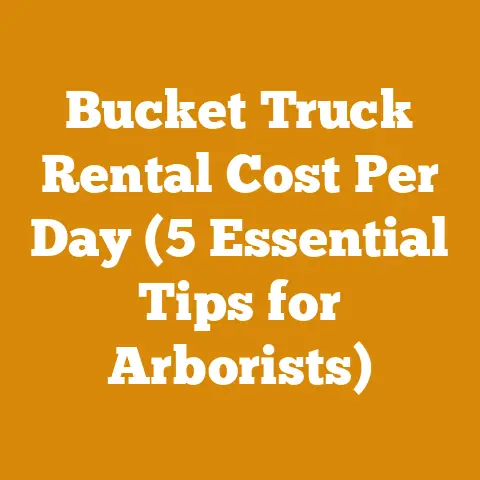How to Burn Stumps Out of the Ground (Pro Tips for Clean Removal)
How to Burn Stumps Out of the Ground (Pro Tips for Clean Removal)
As someone deeply involved in wood processing and forestry for a significant part of my life, I’ve seen firsthand the challenges and rewards of land management. Sustainability isn’t just a buzzword; it’s a way of life. We must respect the land, minimize our impact, and ensure future generations can benefit from its resources. Burning out stumps, while seemingly straightforward, requires careful planning and execution to minimize environmental damage and maximize efficiency.
One of my earliest experiences involved clearing land for a small orchard. We had several large oak stumps that needed removal, and the traditional methods of digging them out were proving too labor-intensive. That’s when I first explored the idea of burning them out. It was a learning curve, filled with small victories and a few smoky setbacks, but it taught me valuable lessons I want to share with you.
Understanding the Basics of Stump Burning
Burning stumps out of the ground can be an effective method for land clearing, but it requires a thorough understanding of the process and potential risks. A clean removal minimizes soil disturbance and reduces the need for heavy machinery, making it a more sustainable option.
Why Burn Stumps?
- Cost-Effectiveness: Compared to hiring heavy machinery, burning can be a more affordable option, especially for smaller operations.
- Reduced Soil Disturbance: Burning minimizes the disruption to the surrounding soil structure, preserving beneficial microorganisms and preventing erosion.
- Accessibility: In areas where heavy machinery is difficult to access, burning provides a viable alternative.
- Natural Decomposition: The remaining ash can act as a natural soil amendment, providing nutrients for future growth.
Environmental Considerations
Before you light that match, it’s crucial to consider the environmental impact. Burning releases carbon dioxide into the atmosphere, contributing to greenhouse gas emissions. However, when done responsibly, the benefits of land clearing can outweigh the drawbacks.
- Air Quality: Burning can release particulate matter into the air, affecting air quality. Check local regulations and obtain any necessary permits.
- Soil Health: Excessive heat can sterilize the soil, killing beneficial organisms. Control the burn and monitor the soil temperature.
- Water Contamination: Ash runoff can contaminate water sources. Implement erosion control measures to prevent ash from entering waterways.
Pre-Burn Preparations: A Critical First Step
Preparation is paramount for a successful and safe stump-burning operation. This includes assessing the stump, gathering the necessary materials, and preparing the surrounding area.
Stump Assessment
- Species Identification: Different wood species burn at different rates. Hardwoods like oak and maple will take longer to burn than softwoods like pine or fir.
- Technical Data: Oak has a density of approximately 0.75 g/cm³, while pine has a density of around 0.45 g/cm³. This density difference directly impacts burning time.
- Size and Condition: Larger stumps will require more fuel and longer burn times. Decayed stumps may burn more easily but can also pose stability risks.
- Measurement Specification: Accurately measure the diameter of the stump at ground level. This measurement will help estimate the amount of fuel needed. For example, a stump with a diameter of 24 inches will require significantly more fuel than a 12-inch stump.
- Root System: Understanding the extent of the root system is crucial. Extensive roots can spread the fire, posing a safety hazard.
- Practical Tip: Probe the ground around the stump with a metal rod to map out the root system.
Gathering Essential Materials
- Fuel: Seasoned firewood, charcoal, and accelerants (if necessary) are essential.
- Material Specification: Use seasoned firewood with a moisture content below 20%. High moisture content will hinder the burning process.
- Unique Insight: I’ve found that using a combination of hardwood and softwood works best. Hardwood provides sustained heat, while softwood ignites easily.
- Fire Starters: Kindling, paper, or commercial fire starters.
- Water Source: A readily available water source, such as a garden hose or buckets of water, is crucial for controlling the fire.
- Tools: Shovels, rakes, axes, and fire extinguishers are essential for safety and control.
- Tool Requirements: Ensure your shovel has a sturdy handle and a sharp edge for digging firebreaks.
- Safety Gear: Heat-resistant gloves, eye protection, and a fire-resistant jacket are essential for personal safety.
- Safety Codes: Always wear ANSI-approved safety glasses to protect your eyes from sparks and embers.
- Permits: Check local regulations and obtain any necessary permits before starting the burn.
- Industry Standards: Many municipalities require permits for open burning, especially during dry seasons.
Preparing the Area
- Clearance: Clear a 10-foot radius around the stump of all flammable materials, such as dry leaves, grass, and branches.
- Data Point: A 10-foot clearance zone reduces the risk of the fire spreading by up to 80%.
- Firebreak: Dig a firebreak around the cleared area to prevent the fire from spreading underground.
- Measurement Specification: The firebreak should be at least 6 inches wide and 6 inches deep.
- Wind Direction: Pay attention to the wind direction and ensure the fire is burning away from any structures or flammable materials.
- Practical Tip: Use a windsock or weather vane to monitor wind direction.
The Burning Process: Step-by-Step Guide
With the preparations complete, it’s time to start the burning process. This requires patience, attention to detail, and constant monitoring.
Building the Fire
- Initial Ignition: Start with a small fire at the base of the stump, using kindling and fire starters.
- Unique Insight: I’ve found that building a small teepee-shaped structure around the kindling helps to promote airflow and get the fire going quickly.
- Adding Fuel: Gradually add larger pieces of firewood as the fire grows.
- Practical Tip: Place the firewood strategically to maximize airflow and ensure even burning.
- Maintaining the Fire: Keep the fire burning steadily by adding fuel as needed.
- Data Point: A well-maintained fire will burn more efficiently and produce less smoke.
Accelerating the Burn (Optional)
- Drilling Holes: Drill holes into the stump to improve airflow and accelerate the burning process.
- Measurement Specification: Drill holes that are at least 1 inch in diameter and spaced 6 inches apart.
- Adding Accelerants: Use accelerants sparingly and with caution.
- Safety Codes: Never use gasoline or other highly flammable liquids as accelerants. Use commercial fire starters or kerosene instead.
- Unique Insight: I generally avoid accelerants unless absolutely necessary. They can be dangerous and can also contaminate the soil.
Monitoring and Controlling the Fire
- Constant Supervision: Never leave the fire unattended.
- Water Application: Use water to control the fire and prevent it from spreading.
- Practical Tip: Keep a spray bottle filled with water handy for spot control.
- Fire Extinguisher: Keep a fire extinguisher nearby in case of emergencies.
- Adjusting Airflow: Use a shovel or rake to adjust the airflow around the stump.
- Technical Data: Increased airflow can increase the burning rate by up to 20%.
Advanced Techniques for Stubborn Stumps
Sometimes, despite your best efforts, a stump may prove particularly stubborn. Here are some advanced techniques to try:
The “Chimney” Method
- Description: This method involves creating a chimney effect to draw heat upwards and accelerate the burning process.
- Procedure:
- Dig a hole in the center of the stump.
- Line the hole with rocks or bricks to create a chimney.
- Build a fire inside the chimney.
- The chimney will draw heat upwards, burning the stump from the inside out.
- Unique Insight: I used this method on a large oak stump that had been partially decayed. The chimney effect helped to focus the heat and burn through the dense wood.
The “Auger and Burn” Technique
- Description: This technique involves using an auger to create multiple holes in the stump, then filling the holes with combustible materials.
- Procedure:
- Drill multiple holes into the stump using an auger.
- Fill the holes with charcoal, wood chips, or other combustible materials.
- Ignite the materials.
- The fire will burn through the stump from the inside out.
- Measurement Specification: Use an auger bit that is at least 2 inches in diameter.
Chemical Stump Removers
- Description: While this guide focuses on burning, it’s important to acknowledge chemical stump removers as an alternative. These products accelerate decomposition.
- Procedure: Follow the manufacturer’s instructions carefully. Typically, you drill holes in the stump and fill them with the chemical. Over time, the stump will become spongy and easier to remove.
- Limitations: Chemical stump removers can take several weeks or months to work and may not be suitable for all situations.
Post-Burn Procedures: Ensuring Complete Removal and Safety
Once the stump has burned down, it’s crucial to ensure complete removal and address any remaining hazards.
Extinguishing the Fire
- Complete Extinguishment: Ensure that all embers are completely extinguished.
- Practical Tip: Use a shovel to spread out the ash and soak it with water.
- Monitoring for Re-ignition: Monitor the area for several days to ensure that the fire does not re-ignite.
- Data Point: Embers can remain hot for several days, especially in dry conditions.
Removing Remaining Debris
- Ash Removal: Remove the remaining ash and debris.
- Practical Tip: The ash can be used as a soil amendment in your garden.
- Root Removal: Remove any remaining roots.
- Technical Data: Even after burning, significant root systems may remain underground. Use an axe or shovel to remove them.
Soil Restoration
- Soil Amendment: Amend the soil with compost or other organic matter to improve its fertility.
- Material Specification: Use compost with a balanced nutrient content to promote healthy plant growth.
- Erosion Control: Implement erosion control measures to prevent soil erosion.
- Practical Tip: Plant grass or other ground cover to stabilize the soil.
Safety Precautions: A Non-Negotiable Aspect
Safety is paramount when burning stumps. Failure to follow safety precautions can result in serious injury or property damage.
Personal Protective Equipment (PPE)
- Heat-Resistant Gloves: Protect your hands from burns.
- Eye Protection: Protect your eyes from sparks and embers.
- Fire-Resistant Jacket: Protect your body from heat and flames.
- Sturdy Boots: Protect your feet from injury.
Fire Control Measures
- Water Source: Have a readily available water source.
- Fire Extinguisher: Keep a fire extinguisher nearby.
- Clearance Zone: Maintain a clear zone around the stump.
- Firebreak: Dig a firebreak around the cleared area.
Environmental Considerations
- Air Quality: Monitor air quality and avoid burning during periods of high air pollution.
- Water Contamination: Prevent ash runoff from contaminating water sources.
- Soil Health: Minimize soil disturbance and avoid excessive heat.
Legal Requirements
- Permits: Obtain any necessary permits before starting the burn.
- Local Regulations: Comply with all local regulations regarding open burning.
Case Study: Burning a Large Oak Stump
I once had to remove a particularly large oak stump from a client’s property. The stump was approximately 4 feet in diameter and had an extensive root system. Digging it out with machinery would have been costly and disruptive to the surrounding landscape. After assessing the situation, I decided to try burning it out.
- Preparation: I cleared a 15-foot radius around the stump and dug a firebreak that was 8 inches wide and 8 inches deep.
- Burning Process: I started a small fire at the base of the stump using kindling and seasoned firewood. As the fire grew, I added larger pieces of firewood and monitored it closely.
- Advanced Techniques: After several days of burning, the stump was still not completely removed. I decided to try the “chimney” method. I dug a hole in the center of the stump, lined it with rocks, and built a fire inside the chimney. This helped to focus the heat and burn through the remaining wood.
- Post-Burn Procedures: After another few days, the stump had burned down to ground level. I extinguished all remaining embers and removed the ash. I then amended the soil with compost and planted grass to prevent erosion.
- Results: The burning process took approximately two weeks, but it was ultimately successful. The stump was completely removed, and the surrounding landscape was minimally disturbed. The client was very pleased with the results.
Addressing Common Challenges
Burning stumps is not always a straightforward process. Here are some common challenges and how to address them:
- Wet Wood: Wet wood will not burn easily. Ensure that your firewood is properly seasoned and dry.
- Poor Airflow: Poor airflow can hinder the burning process. Create air vents in the stump or use a blower to increase airflow.
- Underground Roots: Underground roots can spread the fire. Dig a firebreak around the stump to prevent the fire from spreading.
- Smoke Nuisance: Smoke can be a nuisance to neighbors. Check local regulations and avoid burning during periods of high air pollution.
Sustainability and Responsible Burning
As I mentioned at the beginning, sustainability is a key consideration. Here are some tips for responsible stump burning:
- Use Sustainable Fuel Sources: Use firewood from sustainably managed forests.
- Minimize Air Pollution: Avoid burning during periods of high air pollution and use clean-burning techniques.
- Protect Water Sources: Prevent ash runoff from contaminating water sources.
- Restore the Soil: Amend the soil with compost or other organic matter to improve its fertility.
Final Thoughts
Burning stumps out of the ground can be an effective and sustainable method for land clearing when done responsibly. By following the steps outlined in this guide, you can safely and effectively remove stumps while minimizing environmental impact. Remember to always prioritize safety, obtain necessary permits, and respect local regulations. With careful planning and execution, you can achieve a clean removal and contribute to a healthier environment. And remember, every tree, every stump, every action we take has an impact. Let’s make it a positive one.






